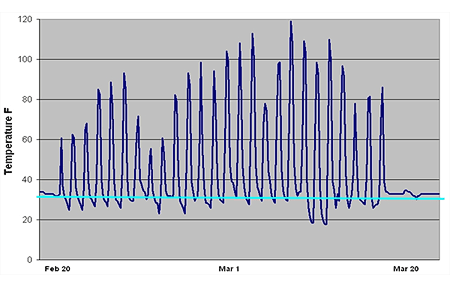ROADSIDE REVEGETATION
An Integrated Approach to Establishing Native Plants and Pollinator Habitat
Learn
Hyrodroseeding Trials
| Location: | SW Century Drive near junction of Highway 45 |
| Lat/Long: | N43o58'59", W121o37'45" |
| Dates Implemented: | October 2004 |
| Client: | Western Federal Lands Highway Division |
| Planners: | R6 Restoration Services Team |
| Contractors: | Wildland Inc. |
| Case Number: | 0008 |
| Date Submitted: | December 2008 |
| Focus Area: | Seeds, mulch, hydromulch |
Background and Objectives
Revegetation of the roadsides for the Sunriver to Bachelor project called for establishing native grass species on 12 miles of roadside. With potentially 35 acres to be seeded, it was important to develop seeding prescriptions that would result in optimum seed germination and plant establishment. A hydroseeding trial was developed to assess the most appropriate hydromulching rates and methods. It was assumed that a small, relatively inexpensive test could yield results that would save money at the much larger scale of the project. The hydroseeding trial would compare the establishment of two species of native grasses, Elymus elymoides (bottlebrush squirreltail) and Bromus carinatus (California brome), with different seed covering treatments: 1) no wood fiber mulch, 2) 1,000 lbs/ac wood fiber mulch, 3) 2,000 lbs/ac wood fiber mulch, 4) 3,000 lbs/ac wood fiber mulch, and 5) 2,000 lbs/ac wood fiber mulch applied in two passes. The treatments would be replicated at four different sites. The results of the study would be used to select hydromulching rates for the Sunriver to Bachelor Highway as well as other highway projects near Sunriver.
Implementation
In mid October 2004, the treatments were installed using a small hydroseeder on 4 unvegetated road cuts, having 2:1 slopes and southern aspects. Except for the different rates of wood fiber mulch, all treatments were treated the same, which included: 1) 20 lbs/ac mycorrhizae, 2)1800 lbs/acre slow release fertilizer, 3) 1 gal/ac seaweed extract, 4) 20 lbs/ac seed mix, and 5) guar tackifier (at rates corresponding to mulch). Ibuttons1 were installed at the surface of the soil for Treatments 1 and 5 for all blocks prior to application of hydromulch.
Findings
A review of the plots six and twelve months after installation showed that none of the plots had become established with grasses (or any other vegetation). The primary cause for this is believed to be the lack of an adequate seed cover. Most seeds need an environment of moderate temperatures and ample moisture for at least one to two weeks for good germination. Hydromulch, at the applied quantities in this trial, did not create the kind of environment needed to protect seeds from drying or extreme temperatures. Temperatures recorded by iButtons placed at the soil surface on these plots showed that surface temperatures fluctuated drastically during the period seeds would be germinating (see graph). In addition hydromulch was not present on many sites 6 months after installation when seeds would be germinating (it was believed that the tackifiers were weakened by the constant freeze thaw processes and moved offsite through wind and ravel).
Figures
The photograph on the left shows the 3,000 pounds of wood fiber mulch treatment2 in October 2004. The photo on the right shows a hydroseeding treatment plot in May 2005. The hydromulch upper portion of the plots is gone and there is no plant establishment.

This graph shows the daily temperature fluctuations just under the hydromulch during a period in late winter 2005 when germination could have been occurring. Besides the stress these diurnal temperature extremes place on the germinating seed, the freeze-thaw forces could have weakened the tackifiers that held together the wood fiber mulch and caused it to be lost.

Applicability
We used these findings to pursue a different approach to seed covering. A coarse wood mulch was created from road right-of-way material, (wood waste that is typically disposed of by burning) and applied over seeded slopes of the Sunriver to Bachelor Highway and Sunriver Interchange projects at a depth of 0.8 to 1.0 inches. Because the material was deeper and coarser than hydromulch, it protected the germinating seeds from surface drying and extreme surface temperatures, while protecting the seed from the erosional forces of wind, rain, and freeze thaw. The result has been very good germination and seedling establishment.
Contact Information
David Steinfeld, USDA Forest Service; 541-552-2912, dsteinfeld@fs.fed.us
1Small, about the size of a nickel, temperature recorders
2Treatment plots were 1,000 square feet in size.